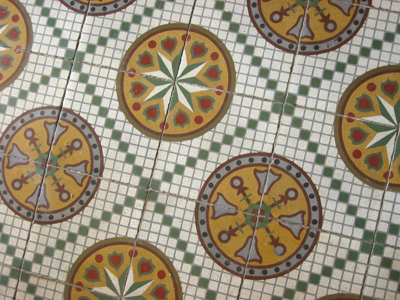
Mystery solved.
For years, I noticed a non-ceramic tile used on the floor of most older churches in downtown Buenos Aires. Those tiles retain their color despite heavy wear, the designs are unique & colors seem muted, earthy. Somehow I always forgot to check into it. But during a visit to the Victoria & Albert Museum in London a couple months ago, my questions were answered.
Encaustic tiles were all the rage from the mid-1700’s to the 20th century, especially in Gothic Revival buildings. Since most tiles of this kind were coming out of England —in particular a company called Craven Dunnill Jackfield, Ltd. located at the heart of the Industrial Revolution in Shropshire (download their catalogs!)— it’s not surprising that they ended up in the churches of Buenos Aires. Commercial ties between England & Argentina were strong in the 1800’s, despite (or perhaps causing) two failed British invasions.
The V&A exhibit explained how the tiles were manufactured. Apologies for the grainy diagram… low museum light.

Stage 1 • A plaster mold is made to shape the pattern on the tile. Colored clays are pushed by thumb into the mold to make the detail of the pattern.
Stage 2 • A layer of strong, red earthenware clay is then pressed onto the top of the mold, using a mawl, a type of soft mallet. The end result will form the base of the tile when it comes out of the mold.
Stage 3 • The wooden frame is removed, then the tile is peeled off the plaster mold. This tile shows the raised main shapes & the layer of red, earthenware clay at the base. Normally an encaustic tile is not fired at this stage.
Stage 4 • Watery clay (called slip) is poured into the hollow gaps between the raised shapes, which stand slightly higher than the slip although they are covered by it. Different colors of slip can be used to create multiple background colors.
Stage 5 • A metal scraper is used to scrape the dried excess slip from the raised decorations, until the top surface is even, revealing the details of the pattern. Then the finished tile is fired.
Alternative methods can be used to create similar tiles without firing. If your Catalan is good, then Pere Martí i Carreras shows the step-by-step process on YouTube in a series of short videos. From what I understood, they try to make all liquid medium at the same density. Then after pouring & pressing, the tiles must dry for 21 days. I didn’t catch anything about firing, then again my Catalan is rusty! Read the comments at the end of the post for further clarification.
The following video (no sound) shows the same process. I would love to learn how to do this!
To see these tiles in Buenos Aires, check out most of the churches downtown. Some of the most spectacular examples are at the Basílica de San Francisco (Alsina & Defensa) & the Iglesia de la Santísima Trinidad (San Martín 1035), shown respectively below:
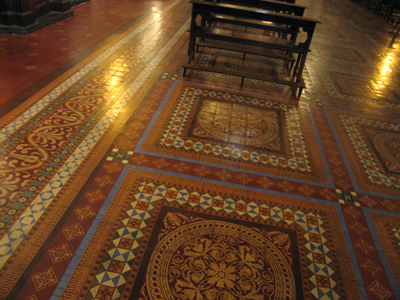
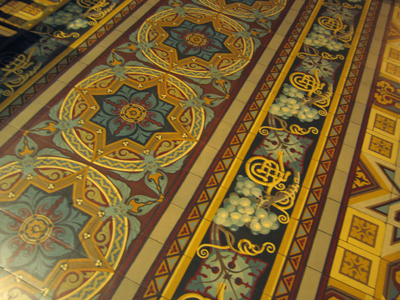
Now comes the tricky part. Churches had less budget constraints & could afford fired more expensive encaustic tiles. But a non-fired cement tile (named for its major component) looks very similar. To my untrained eye, I wouldnt know the difference. But several comments (see below) assure me that several of these pics are of baldosas calcáreas. Always learning something new! In Balvanera, the wonderfully restored Café de los Angelitos (Avenida Rivadavia & Rincón) sports floor tiles:
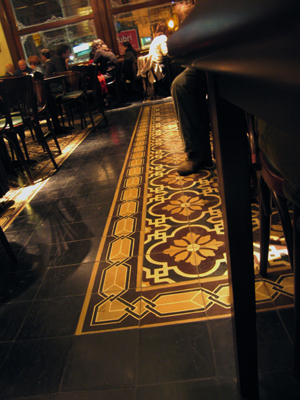
Further afield in the neighborhood of Barracas, the train station Hipólito Yrigoyen (Juan Darquier, 900 block) has some worse-for-wear examples. Better preserved are the tiles inside the Instituto Santa Felicitas:
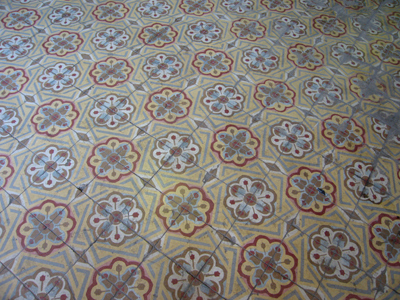
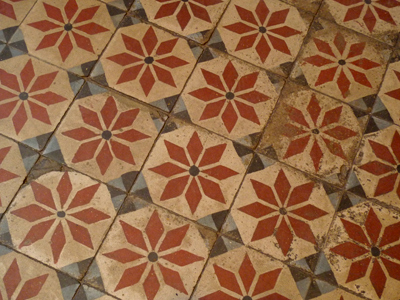
It would be wonderful to find out if any tiles came from Craven Dunnill Jackfield, but there’s probably no record anywhere of their origin… & I won’t be tearing up tiles just to look at the back for clues 🙂 Tiles —whether encaustic or cement— can often be found in hallways in the casa chorizo, popular during the same era. Happy hunting!
Interesting! I have seen these types of tiles here in Necochea as well (in fact, my in-laws’ home is tiled with them), but I didn’t know their name or origin. Thanks, as always, for the research!
Hi Katie! Actually that first photo in the post is from the town hall in Saavedra, & I have other tile photos from the town hall in Bahía Blanca. They must have been economical as well as popular. Do me a favor… when you go to your in-laws’ any time soon, ask if they have a loose tile & see if there’s a company name on the back. I know, I’m crazy! Thanks!
¡Hola! ¡Qué interesante! Mi esposa y yo tenemos un taller de diseño y producción cerámica especializado en rproducción de teselas y baldosas victorianas de gres. Efectivamente, la mayoría de estas piezas provino de Stoke-on-Trent, Inglaterrra.
Actualmente estamos trabajando en la reproducción de dos modelos de baldosas (tiles) encáusticas para la iglesia de San Ignacio de Loyola, de gran importancia histórica ya que es el edificio más antiguo de Buenos Aires.
Aunque no puedo saberlo sólo con mirar las fotos en tu artículo, tengo la impresión de que varios ejemplos que vemos en tus ejemplos son baldosas calcáreas, es decir, no son piezas cerámicas como las tradicionales inglesas. Me gustaría verificar ésto, y en mi próxima visita a Buenos Aires iré a ver.
Gracias por la información tan valiosa y estoy a tu disposición por cualquier dato que pueda brindar.
Have a nice time!
Luis
Hola Luis! Gracias por escribir… super interesante que Uds van a fabricar las nuevas baldosas para la Iglesia de San Ignacio. Me encanta esa iglesia y tiene un valor patrimonial sin igual. Vos sabés más del tema que yo, pero todas las fotos que subí en el post son de baldosas encáusticas… es lo mismo que una baldosa calcárea, no? A mi me parece que estan hechas de la misma manera. Creo que son dos formas de llamar el mismo proceso.
Me encantaría documentar lo que estás haciendo… y también te quiero decir que los floreros son lindísimos. La serie de 3 dpv es alucinante! Por favor, avisáme cuando pases de nuevo por Capital. Un abrazo!
Robert,
Gracias por tu mail. Lo respondí pero mi mail regresó rebotado, no sé porqué. Lo transcribo aquí:
Hola Robert,
Bueno, hay un cierto vacío de léxico profesional en español relativo a “encaustic tiles”. Tal como se utiliza el término en inglés, es para referirse a las baldosas de material cerámico de alta temperatura. Las baldosas calcáreas son hechas con cemento coloreado, con un procedimiento parecido, y tienen otra calidad y por supuesto menos durabilidad. Creo que las segundas son la imitación más económica de las primeras.
Según puedo ver en tus fotos, varias me parecen calcáreas. Pero tendría que verlas en vivo y en directo.
Gracias por mirar mi sitio web, apenas improvisado para tener algo en internet. Espero tener algo de tiempo para construirlo, pues luego del trabajo del Colón continuamos con otros trabajos interesantes: el Palaciuo Ferreyra en Córdoba, y actualmente el piso del nártex de la iglesia de San Ignacio y el mosaico del hall de entrada del Club español.
Aparte de éso, me dedico a diseñar y producir otras piezas de gres y porcelana. Realmente me alegro mucho de que te hayan gustado los floreros (¡la decoración es un chiste para diseñadores gráficos que utilizamos siempre imagenes en 72, 300 y 600 dots per inch!).
Ahora estoy terminando varios diseños nuevos y me encantaría mostrártelos.
Te felicito por tu blog y por tantas novedades y aventuras.
Un abrazo
Luis
Hola Luis –
De vez en cuando esta cuenta tiene problemas… Gracias por copiar tu mensaje al blog.
Entonces seria el mismo proceso para ambas pero lo que diferencia las encáusticas de las calcáreas es la calidad de la material para fabricarlas. Entiendo. Supongo que las baldosas que usaban para las iglesias eran de primera calidad, tambien para las estaciones de tren o cualquier otro edificio público. Y como el pais importaba mucho de Inglaterra en esa época, no me sorprende que hay tantas en Buenos Aires. Como dije en el post, me encantaría aprender a hacer el proceso porque parece fascinante. Que suerte para nosotros en Capital que tenés el conocimiento para reproducirlas!
De nuevo, si venís a Buenos Aires, por favor avisáme. Te invito a un café y charlamos de la arquitectura y de la cerámica!
Un abrazo,
Robert
Robert, Your investigation is very good! These floors are beautifull! But, most of these kind of floors are not “encaustic floors”. They are “cement floors” also called “encaustic cement floors” or “calcareos” in spanish language. The difference is that encaustic floors are ceramic tiles kiln fired, not painted, not glazed. The colour comes from different colour of clay used. “Calcareos” floors, are not fired. They are made in a mould, pouring pigmented cement in the spaces and then pressed. The method was discovered in south of France in the middle of XIX century. The quality of what you have seen in Buenos Aires is so good, that you can still appreciate the floors like new after more than one hundred years! Kind regards. Fernando Teryda – Miramar – Argentina
Hola Fernando – I think there has been a language problem here because your comment describes exactly the content of the post. So I’m confused. The correct term in English is “encaustic” & the video shows the process you mention. Are you confused because of the word “tiles”?? En inglés significa más que “azulejo”… anyway, thanks for taking the time to write. Miramar is a nice place! Saludos!
Hello Robert, sorry for the delay. The process that you described as encaustic floors made of encaustic tiles is perfect. What I mean is that these kind of tiles are made of clay and fired afterwards, while the common floor tiles you have seen in Buenos Aires are made of cement -also using moulds-, not fired. Most of the references for “encaustic” tiles I’ve got from British books, are pointed to the clay-fired ones, not for the cement ones.
I have near four hundreds 6′ x 6′ different relief glazed wall tiles (Victorian and Art Noveau majolica) from the end of XIXth century and beggining of the XXth., mostly salvaged from Buenos Aires but I have only one encaustic floor tile at the moment. Thank you for what you say about Miramar! You will be welcome here next time. Saludos!
Hello Fernando – Thanks for answering! I’ve been in Milan without my computer, so I’m just now checking my emails. Between you & Luis, the different production methods are now clear. I should rewrite some of the post above. Thank you very much for the clarification! 400 tiles salvaged from Buenos Aires?!?! Deberías abrir un museo! Me encantaría pasar y verlos!! Un abrazo!